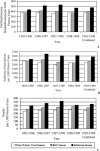Influenza- and respiratory syncytial virus-associated morbidity and mortality in the nursing home population
- PMID: 12757561
- PMCID: PMC7159134
- DOI: 10.1046/j.1365-2389.2003.51254.x
Influenza- and respiratory syncytial virus-associated morbidity and mortality in the nursing home population
Abstract
Objectives: To estimate winter viral-related morbidity and mortality in Tennessee nursing home residents during 4 consecutive years.
Design: A retrospective cohort study.
Setting: Three hundred eighty-one Tennessee nursing homes.
Participants: Nursing home residents.
Measurements: Viral surveillance data were used to define three seasons: influenza (influenza and respiratory syncytial virus (RSV) cocirculating), RSV (RSV alone circulating), and non winter-viral (neither virus circulating). Adjusted seasonal differences in rates of cardiopulmonary hospitalizations, antibiotic prescriptions, and deaths during these three seasons were calculated to estimate annual hospitalizations, courses of antibiotics, and deaths attributable to influenza and RSV from 1995 to 1999.
Results: Nursing home residents had 81,885 person-years of follow-up. In the 63% of residents with comorbid conditions that increase influenza morbidity, influenza infection contributed to an estimated average of 28 hospitalizations, 147 courses of antibiotics, and 15 deaths per 1,000 persons annually. Similarly, RSV accounted for an annual average of 15 hospitalizations, 76 courses of antibiotics, and 17 deaths per 1,000 persons. Influenza and RSV accounted for 7% of cardiopulmonary hospitalizations and 9% of total deaths in high-risk residents during the 4 study years. Absolute morbidity and mortality were lower in residents without identified comorbid conditions but accounted for 15% of hospitalizations and 14% of deaths. These estimates depend on the assumption that morbidity and mortality from other respiratory viruses were distributed evenly between the three defined seasons.
Conclusion: Influenza and RSV substantially increased hospitalization rates, antibiotic use, and deaths in elderly nursing home residents each winter. These data should encourage persistent efforts toward disease prevention, and thoughtful study of vaccine development and delivery, diagnostic tools, and methods of prophylaxis and therapy.
Figures

References
-
- Agius G, Dindinaud G, Biggar RJ et al An epidemic of respiratory syncytial virus in elderly people: Clinical and serological findings. J Med Virol 1990;30: 117–127. - PubMed
-
- Drinka PJ, Gravenstein S, Krause P et al Outbreaks of influenza A and B in a highly immunized nursing home population. J Fam Pract 1997;45: 509–514. - PubMed
-
- Falsey AR. Noninfluenza respiratory virus infection in long‐term care facilities. Infect Control Hosp Epidemiol 1991;12: 602–608. - PubMed
-
- Falsey AR. Respiratory syncytial virus infection in older persons. Vaccine 1998;16: 1775–1778. - PubMed
-
- Goodman RA, Orenstein WA, Munro T et al Impact of influenza A in a nursing home. JAMA 1982;247: 1451–1453. - PubMed
Publication types
MeSH terms
Grants and funding
LinkOut - more resources
Full Text Sources
Other Literature Sources
Medical

